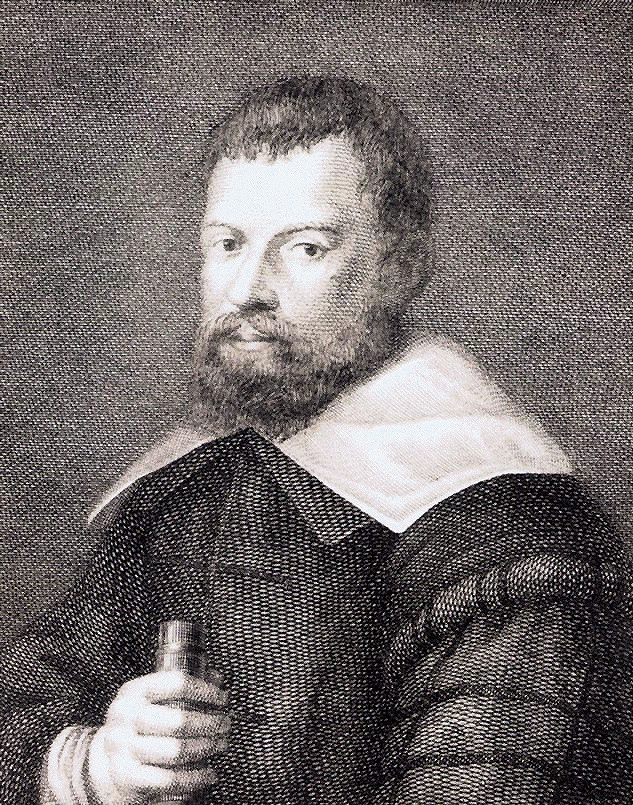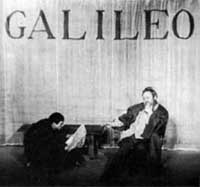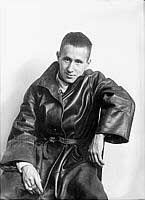| For our first common text of spring 2002, we will be reading
Bertolt Brecht's The Life of Galileo, which was written between 1937-1939 and translated into English by Brecht and Charles Laughton in 1947. In addition to the following sites, you might find it interesting to search for ``Galileo'' and the ``Pope'' in magazine and newspaper sources in the US and Europe since 1980. Pope John Paul II began to restore the image of Galileo in 1980 culminating with the papal apology in 1992 for the silencing of Galileo.
|
Links to sites about Brecht:
-
Bertolt Brecht Turns 100
, A Web Exhibit, from the University of Southern California. Includes information on the first English language production of the play in Los Angeles in 1947 and Brecht's testimony before the House Committee on Un-American Activities on October 30, 1947.
-
The Brecht Centennial
web site from The Versuche Ensemble, with biography, play listing, photos, links and music.
-
The International Brecht Society
, home page at the University of Wisconsin. Includes reviews of recent production of The Life of Galileo and chronology of Brecht's life.
-
Bertolt Brecht
, from the Internet Movie Data Base (IMDB), includes a filmography of the filmed works of Brecht.
-
Galileo
, the 1975 American Film Theatre version of the play directed by Joseph Losey, from the Internet Movie Data Base (IMDB).
|
Links to sites about Galileo Galilei:
-
The Galileo Project
, an extensive hypertext source of information on the life and work of Galileo Galilei
(1564-1642) and the science of his time. From Rice University.
-
Galileo Galilei
web site at Galileo Museum in Florence, Italy (in English).
-
The Art of Renaissance Science: Galileo and Perspective
a web project authored by Joseph W. Dauben of the City University of New York.
-
Galileo Galilei's Notes on Motion
an electronic representation of Galileo's manuscript jointly sponsored by Biblioteca Nazionale Centrale, Florence Istituto e Museo di Storia della Scienza, Florence Max Planck Institute for the History of Science, Berlin.
-
Galileo and the Rise of Mechanism
notes from a course by Prof. Fred L. Wilson of the Rochester Institute of Technology.
-
Starry Messenger
(Sidereus Nuncius after Galileo), an exceptional site located at the Department of History and
Philosophy of Science of the University of Cambridge, which includes extensive cross-referenced pages on, among others, Ptolemy, Copernicus, Brahe, Kepler and Galileo.
|
Giordano Bruno (1548-1600) (see Scene 3 of Galileo)and Christopher Clavius (1538-1612) (see Scene 5 of Galileo):
- Giordano Bruno, from the New Advent Catholic Encyclopedia.
- Giordano Bruno presented by Switch, a new media art journal, at the CADRE Institute of the School of Art and Design at San Jose State University.
- The Folly of Giordano Bruno. by Prof. Richard W. Pogge, College of Mathematics and Physical Sciences at Ohio State University.
- Christopher Clavius, from the New Advent Catholic Encyclopedia.
- Christopher Clavius, from the School of Mathematics and Statistics University of St. Andrews, Scotland.
- Christopher Clavius, S.J. and his Gregorian calendar, from the web site maintained by Joseph MacDonnell, S.J., of the Mathematics Department at Fairfield University.
|
The Solar System and Beyond:
-
STSI, the website Space Science Telescope Institute, home of the Hubble Space Telescope. This site contains a large catalogue of amazing, high quality images of the solar system, the galaxy, and the universe produced by the Hubble telescope.
-
Project Galileo: Bringing Jupiter to Earth
, the website of NASA's Jupiter exploration project, at the Jet Propulsion Laboratory in Pasadena, CA.
-
Project Galileo: Bringing Jupiter to Earth
, the website of NASA's Jupiter exploration project, at Caltech's Jet Propulsion Laboratory in Pasadena, CA.
-
The Nine Planets
, a multimedia tour of the solar system designed by Bill Arnett. This is located at
SEDS
, hosted by Students for the Exploration and Development of Space Chapter at the the University of Arizona Lunar and Planetary Lab.
-
NASA
, the home page of the National Aeronautics and Space Administration.
-
Windows to the Universe
, a fun and different Web site about
the Earth and Space sciences, sponsored by the University Corporation for
Atmospheric Research (UCAR) of the University of Michigan.
-
SDSS
, the Sloan Digital Sky Survey, a project at the University of New Mexico to develop the most
detailed sky map to date.
|





